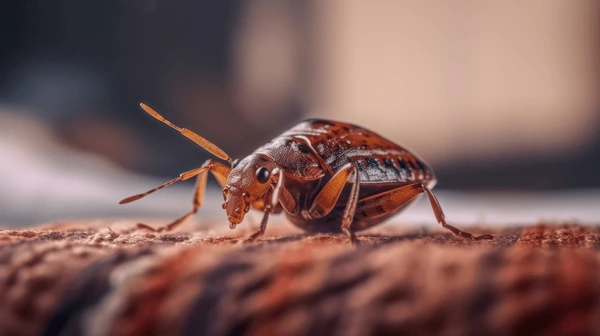Unveiling the Silent Menace: The Unknown Threat of Bed Bugs in Your Bedroom
- Sonville
- Dec 4, 2024
- 4 min read
Updated: Oct 24
When night falls and the world outside gets quiet, sinking into a warm bed is a comforting ritual. Yet, sometimes, an unwanted guest might be lurking in the shadows, ready to disturb your peaceful rest: the bed bug. These tiny, elusive pests have returned in force in recent years, causing worry for homeowners and travelers. In this blog post, we’ll dive into what bed bugs are, how to spot them, and effective ways to keep your sleep environment safe.
Understanding Bed Bugs
Bed bugs, known scientifically as Cimex lectularius, are small, flat insects that are reddish-brown in color. Adult bed bugs reach roughly 4-5 mm in length, making them about the size of an apple seed. While their name suggests they only inhabit beds, these pests can hide in various spaces, clinging to items like luggage, furniture, and clothing, seeking warmth and blood to feed.
After almost disappearing in the mid-20th century, bed bugs have made a startling resurgence. A study by the National Pest Management Association revealed that 97% of pest control professionals have encountered bed bugs in the past year, largely due to increased global travel and resistance to some pesticides. Understanding their behavior is key to effective detection and elimination.
Signs of Bed Bug Infestation
Catching bed bugs in their early stages can save you from an uphill battle. Here are clear signs that bed bugs may be invading your sleeping space:
Bites on Skin: Bed bug bites can appear as small, red, itchy welts, typically clustered or arranged in a line. A study indicated that about 70% of individuals will have a reaction to these bites.
Blood Stains: Look for small blood stains on your linens or pajamas, often caused by squished bugs or during feeding.
Dark Spots: Tiny, dark fecal spots, roughly the size of a pinhead, might be visible on your bedding. These spots can easily be mistaken for mold or dirt.
Eggs and Skins: Bed bug eggs are tiny, white, and oval-shaped, measuring about 1 mm. Shed skins that resemble their bodies can also be found in hiding spots.
If you suspect an infestation, swift action is essential. Detecting the problem early makes it much easier to eradicate it.
Identifying Common Hiding Spots
Bed bugs are masters of disguise, making them hard to locate. They thrive in dark, tight spaces for safety during the day. Here are common areas to check:
Mattress seams and tags: These are prime spots for bed bugs to hide and lay their eggs.
Bed frames and headboards: Inspect these areas carefully, as they often harbor larger populations.
Couches and chairs: Upholstered furniture in close contact with walls can become a haven for bed bugs.
Baseboards and carpet edges: Check for dark spots or eggs here since bed bugs use these areas to travel to and from your sleeping area.
Always remember to inspect your luggage after traveling, as this is a frequent way for bed bugs to hitch a ride home.
Bed bug Prevention Strategies
To keep bed bugs at bay, a proactive approach is key. Here are practical strategies:
Regular Inspections: Make it a habit to check your mattress, bed frames, and nearby areas regularly for signs of bed bugs.
Wash and Heat-Dry Bedding: Clean your bedding in hot water and dry on high heat. This can kill any potential bed bugs and their eggs.
Encasement: Use bed bug-proof encasements for your mattress and pillows. These covers can trap existing bugs while preventing new ones from entering.
Declutter: A tidy sleeping area reduces hiding spots for bed bugs.
Travel Cautiously: Before unpacking at hotels, check for signs of bed bugs. Elevate your bags off the floor and inspect all items before bringing them home.
How to Handle a bed bug Infestation
If you confirm a bed bug infestation, stay calm. Here are effective steps to take:
Seek Professional Help: While some DIY methods are available, bed bugs can be tough to eliminate without professional assistance. Sonville Environmental has advanced techniques and products specifically for effective removal.
Heat Treatment: Bed bugs cannot survive temperatures above 48°C. Heat treatment can kill them effectively, along with their eggs.
Vacuuming: Regularly vacuum areas where bed bugs may be hiding. Dispose of vacuum bags immediately in sealed plastic bags to prevent any bugs from escaping.
Ongoing Monitoring: After treatment, check your space regularly for any signs of re-infestation. Staying vigilant is crucial.
The Psychological Impact of Bed Bugs
A bed bug presence goes far beyond just physical discomfort; it can drastically impact psychological well-being. The stress, anxiety, and embarrassment linked to an infestation can cause sleep disturbances and an overall feeling of unease. Staying informed and proactive can help reduce this stress, giving you the power to act before the situation gets worse.
Safeguarding Your Sleep Sanctuary
Bed bugs may be small, but their effects can be significant. By knowing what they are and how to recognize their signs, you can take steps to prevent and treat infestations. A proactive approach is your best weapon against this hidden threat. Remember to inspect, protect, and act to ensure peaceful nights. With the right knowledge and tools, you can reclaim your bedroom as a restful getaway, free from the disturbance of bed bugs.
If you ever find yourself in doubt, don't hesitate to contact Sonville Pest Control Edinburgh. They can help banish these unwanted guests for good, allowing you to sleep soundly once more. And remember, sleep tight and don't let the Bed Bugs bite.







Comments